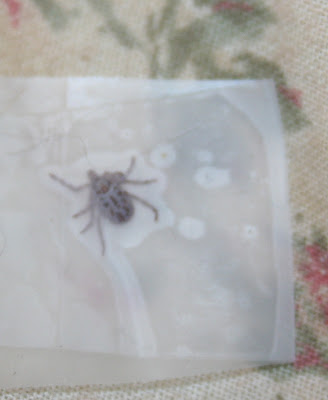Â

Whether you’re talking about the tiny black deer ticks,
Ixodes scapularis, or the larger brown wood or dog ticks
, Dermacentor variabilis, ticks are more than just a gardening nuisance. Carriers of tick born illnesses such as Lyme Disease, several relapsing fevers, ehrlichiosis, and tularemia to name but a few, they are a significant health hazard to both people and pets.
Where we live in coastal Massachusetts, ticks are a particularly serious problem. And even though the diseases caused by ticks are serious, the problems associated with tick repellants are equally problematic, never mind the fact that they aren’t completely effective in any event.
 |
Emily was successfully treated for Lyme disease. |
Most chemical tick control agents (such as Biospot or Frontline), do little or nothing to actually repel a tick from climbing onto your dog and nothing for the ticks that you carry in yourself on your clothing. They kill ticks that climb onto your dog but that can take up to 48 hours. Even utilizing one of those products, we found ourselves removing several ticks a day from each dog, and it wasn’t unusual for a tick to fall off the dog onto us or our bed.
With one dog already having had a bout of Lyme Disease, we are quite aggressive in the treatment of our pets and yard for ticks. Most “natural” repellants that are commercially available consist of essential oils in an oily or watery base. I find that witch hazel makes a very nice base for these kinds of mixtures; there is no oil to stain clothing and it dries nicely on the dogs as well as us.
My recipe is simple: In a clean spray bottle, combine one bottle (16 ounces) witch hazel and one small bottle (about 15 ml) of each of the following essential oils: oil of eucalyptus, oil of lemon grass, and oil of rose geranium. The oils will float on top of the witch hazel so shake the bottle gently to mix before spraying.
I spray the dogs with special attention to their legs, tails, bellies, chest, and under their chin twice a week and that goes a long way toward preventing ticks from hitchhiking into the house in their fur. We still check them carefully twice daily, but the number of ticks we’re finding has been reduced to one or two a week on all of the dogs, down from 3-4 daily on each dog.
I also recently obtained a homeopathic tick repellant from our holistic vet that is added to the dog’s water every time you change the water in the bowl. Since we have been somewhat inconsistent about using it every time we change water (we have several water bowls, several people changing the water, and I keep the drops in the kitchen so they are often overlooked), I can’t verify that it has made a substantial difference, but I have to acknowledge that it also may be playing a role as a tick repellant as well.
We also add oil of rose geranium to our general garden spray at least once a month. That, along with home made garlic oil, helps control the number of ticks and fleas in the environment; we have yet to have any issues at all with fleas and we do notice a dramatic decrease in the number of ticks we observe on our dogs, on us, and in our home when we spray on a regular basis. You can find our entire protocol here.
But ticks still manage to find their way into the house. We check the dogs daily for stowaways and we check ourselves when we come in from gardening. Light colored clothing makes them easier to spot but not infrequently we will spy one crawling on the furniture or floor, most definitely having traveled indoors on our clothing.
A handy way to quickly trap and permanently secure them when you spot them crawling on clothing, furniture or the floor is with adhesive tape. They readily adhere to the tape and when you fold the tape over on itself, they are permanently imprisoned and can be tossed into the regular trash.
 |
Stuck to the tape, the tip can’t extricate itself from the adhesive. |
 |
Fold the tape over on itself and dispose of the tick in the trash. |
 |
It’s a quick, hands off way to quickly trap and dispose of a tick permanently. |
For ticks that attach themselves to the dogs, we keep a small jar with several ounces of cooking oil and a pair of heavy large tweezers handy. After removing the tick, they are dropped into the oil where they smother. Every few weeks, the jar is disposed of in the trash and a “new” jar prepared.






